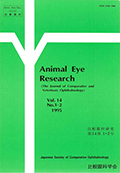Volume 14, Issue 1-2
Displaying 1-10 of 10 articles from this issue
- |<
- <
- 1
- >
- >|
Facilities in the Field of Comparative Ophthalmology
-
1995 Volume 14 Issue 1-2 Pages 1-2_1-1-2_6
Published: 1995
Released on J-STAGE: December 25, 2020
Download PDF (2067K)
The 14th Annual Meeting of the Society
Reports
-
1995 Volume 14 Issue 1-2 Pages 1-2_7-1-2_14
Published: 1995
Released on J-STAGE: December 25, 2020
Download PDF (2451K) -
1995 Volume 14 Issue 1-2 Pages 1-2_15-1-2_22
Published: 1995
Released on J-STAGE: December 25, 2020
Download PDF (2276K) -
1995 Volume 14 Issue 1-2 Pages 1-2_23-1-2_29
Published: 1995
Released on J-STAGE: December 25, 2020
Download PDF (1784K)
Case Reports
-
1995 Volume 14 Issue 1-2 Pages 1-2_31-1-2_34
Published: 1995
Released on J-STAGE: December 25, 2020
Download PDF (806K) -
1995 Volume 14 Issue 1-2 Pages 1-2_35-1-2_38
Published: 1995
Released on J-STAGE: December 25, 2020
Download PDF (925K)
Original Reports
-
1995 Volume 14 Issue 1-2 Pages 1-2_39-1-2_47
Published: 1995
Released on J-STAGE: December 25, 2020
Download PDF (2938K) -
1995 Volume 14 Issue 1-2 Pages 1-2_49-1-2_58
Published: 1995
Released on J-STAGE: December 25, 2020
Download PDF (3285K)
Information & Data
-
1995 Volume 14 Issue 1-2 Pages 1-2_59-1-2_63
Published: 1995
Released on J-STAGE: December 25, 2020
Download PDF (1728K) -
1995 Volume 14 Issue 1-2 Pages 1-2_65-1-2_71
Published: 1995
Released on J-STAGE: December 25, 2020
Download PDF (1867K)
- |<
- <
- 1
- >
- >|
